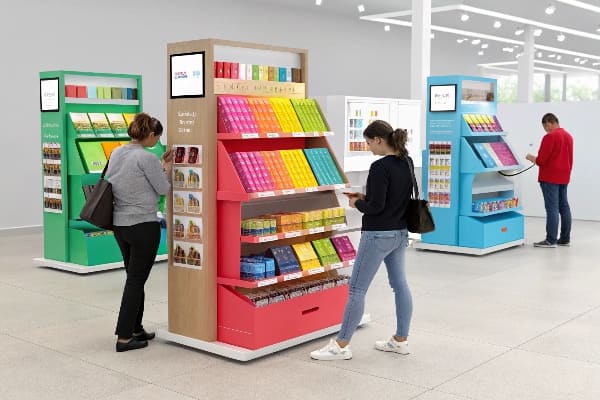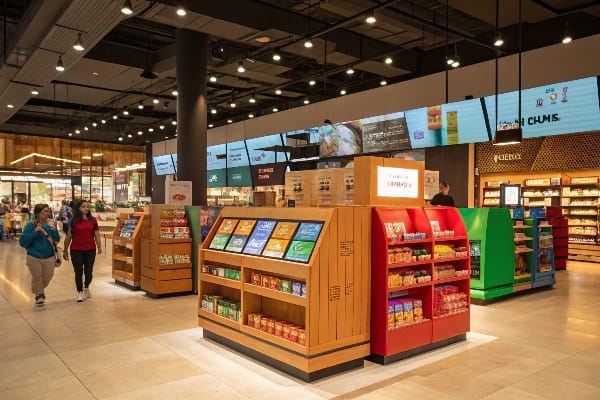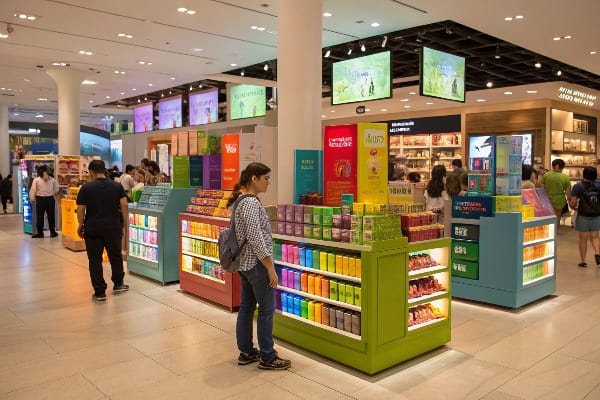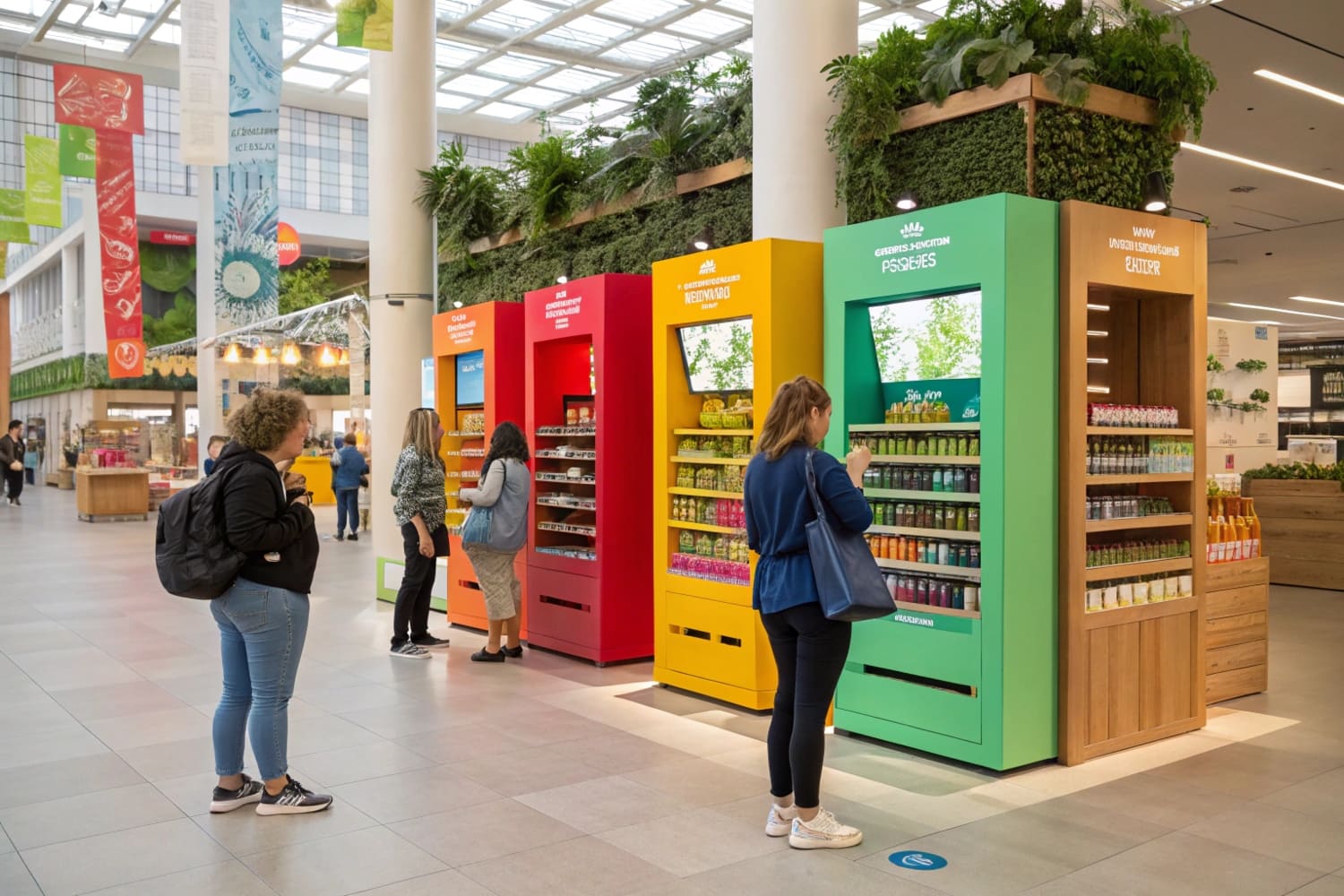Many brands invest in great products but still lose visibility in busy stores. I see this every week when customers ask why shoppers walk straight past their displays.
Our customers place media display fixtures everywhere shoppers make decisions: in big box chains, club stores, supermarkets, outdoor retailers, pharmacies, electronics shops, trade shows, checkout lanes, and even small convenience stores across North America, Europe, and Asia.

When I look at our order history, I see one clear pattern. The same cardboard display structures travel into very different channels. Hunting products in a US outdoor chain, beauty items in a UK pharmacy, snacks in an Australian supermarket, and toys in a Canadian club store all use similar media fixtures. The design language changes, the load requirement changes, the artwork changes, but the basic idea stays the same. The fixture needs to catch the eye quickly, carry the right weight, and survive transport. In the following sections, I break the topic into simple questions that most buyers ask me on the first call.
How do retail stores display their merchandise?
When I walk a store with a buyer, the biggest confusion is not the product itself, but how to place it so shoppers can notice it quickly.
Retail stores display merchandise through a mix of store shelves, permanent fixtures, and temporary cardboard displays that guide shoppers from entrance to checkout, grouping products by category, promotion, and impulse buying moments.

Key display zones I see in most stores
In most projects I support, the store layout follows a simple path. Shoppers enter through a high impact zone1, move into long aisles, and then slow down again near checkout. Each zone has a different job, so each zone needs different fixtures. When I design a cardboard display2, I always ask the buyer which zone we target first, because that decides height, footprint, and loading.
In entrance areas, retailers want a strong first impression. This is where we place tall floor displays, standees, or pallet displays with bold media panels. In main aisles, stores rely more on regular shelving, end caps, and side kick displays that attach to existing fixtures. Near checkout, we move to compact countertop displays and clip strips that focus on impulse items. When we respect these roles, the same product can perform very differently.
Here is how I usually explain the zones during a layout review:
| Store zone | Typical fixtures and displays | How my customers use it |
|---|---|---|
| Entrance / front | Floor displays, pallet displays, standees | New launches, seasonal campaigns, big hero products |
| Main aisles3 | Shelving, end caps, side kicks, shelf-ready trays | Core range, cross-merchandising, category stories |
| Secondary locations | Aisle ends, power wings, dump bins | Price deals, bulk packs, trial sizes |
| Checkout area4 | Countertop displays, clip strips, small floor units | Impulse add-ons, accessories, samples |
| Specialty corners | Branded zones, shop-in-shop cardboard theatres | Full brand experience, high margin lines |
One of my favorite walks was with an outdoor hunting brand in the US. Their crossbows5 sat quietly on a metal rack, hidden behind other gear. We added a tall cardboard floor display with bold imagery next to the rack and a small matching countertop unit near checkout. The product itself did not change, but their sell-through6 increased because shoppers could finally see and touch the items in the right zones.
What are fixtures in a retail store?
Many buyers use the word "fixture" every day, but we often mean different things. Sometimes we talk about hardware, sometimes we talk about the full branded display.
Fixtures in a retail store are the physical structures that hold and present merchandise, such as shelves, racks, pallets, dump bins, and cardboard displays, which organize products, support weight, and show pricing and branding.

How I explain fixtures to new buyers
When I speak with a new buyer, I first separate "fixtures" into two groups. The first group is permanent fixtures7. These are metal racks, wooden gondolas, wall systems, and glass cases. The retailer invests in them once and expects them to stay in place for many years. The second group is temporary or semi-permanent fixtures. This is where cardboard displays sit, together with some lighter metal or plastic units.
Permanent fixtures build the skeleton of the store. Temporary fixtures bring the marketing story to life. My factory does not produce the skeleton; we build the muscle and clothing. We print the brand colors, add media panels, planogram the shelves, and make sure the structure is strong enough for the campaign length. When both groups work together, the whole store feels planned and not random.
Here is a simple way I break it down during a project kickoff:
| Fixture type | Typical materials | Lifetime in store | Main purpose |
|---|---|---|---|
| Permanent shelving8 | Metal, wood, glass | 5–10 years | Basic product storage and navigation |
| Wall systems | Metal grids, slatwall | 3–10 years | Vertical display and hanging items |
| Gondola units | Metal, wood | 5–10 years | Category blocks and aisle structure |
| Cardboard floor display9 | Corrugated cardboard | 4–16 weeks (campaign based) | High impact promotion and storytelling |
| Pallet display | Pallet + cardboard sleeve | 2–12 weeks | Bulk or club store promotion |
| Countertop display | Cardboard, sometimes acrylic | 2–12 weeks | Impulse and small item focus |
As demand for sustainability grows, more retailers ask if cardboard fixtures10 can replace some semi-permanent units. In some channels they can. We use stronger corrugated board11, smart folding structures, and water-based coatings. The unit still counts as a fixture, but it is lighter, easier to ship, and easier to recycle. For buyers, this means they can refresh the brand story more often, without fighting with old hardware.
What type of displays seem to be more attractive to customers?
Every buyer asks me the same thing: which display will actually stop my shopper. I ask the same question, because a beautiful structure without impact is wasted money.
Displays that attract customers usually combine clear messaging, strong vertical presence, simple navigation, easy product access, and sustainable cardboard materials, so shoppers see them quickly, understand the offer, and feel relaxed picking up the product.

Traits of high performing displays12 I see
Over the years, I have reviewed many sell-through reports with our clients. The displays that perform best share a few simple traits. They are not always the most complex structures. Instead, they make it very easy for a shopper to see the hero product, read one key benefit, and reach for the pack without effort. The structure supports this goal; it does not distract from it.
Color contrast matters a lot. I often keep the structure clean and let the product color do the work. Vertical height also matters. A floor display that reaches eye level is more visible than a low unit. Good displays also respect human behavior. Shoppers do not like to bend very low or stretch too high. They want clear price labels. They want the pack to sit stable when they touch it. Sustainability now plays a role as well. Many customers tell me they feel better when the display looks recyclable and avoids heavy plastic.
I worked with one hunting brand that sells crossbows13 and accessories14 in the US and Canada. Their team already had strong product photography and a precise design. We translated that into a tall, narrow cardboard floor display that used bold side panels but very simple shelves. We added clear hooks for accessories at hand level and a clean price strip. The brand reported better visibility and faster sell-through, even though the footprint stayed small.
Here is how I summarize the traits during design reviews:
| Display trait | Why it works for shoppers | Example from my factory |
|---|---|---|
| Clear single message15 | Shoppers read one idea in one glance | "Zero-in fast" headline for a crossbow launch |
| Strong vertical shape | Stands out above shelf level | 1.6–1.8 m floor units in club and outdoor stores |
| Easy reach | Products in chest to waist height | Middle shelves loaded with best-selling SKUs |
| Stable product holding | Packs do not wobble or fall | Custom die-cut trays for heavy hunting equipment |
| Simple navigation | Logical grouping and clean price strips | Accessories grouped by use case on each shelf |
| Sustainable feel16 | Plain cardboard edges, water-based inks | Natural kraft look for eco-focused collections |
When we design with these traits in mind, "attractive" becomes measurable. It shows up in dwell time, pick-up rate, and repeat orders. That is why I accept some design changes that reduce my short-term margin, if they make the display easier to shop and more likely to be reordered.
How many types of displays are there in retail stores?
When I talk about display types, many customers feel lost in the jargon. In reality, the list is clear, and it follows simple shopper and logistics needs.
There is no single fixed number, but most retail programs use six to eight main display types, including floor, pallet, end cap, shelf-ready, countertop, clip strip, standee, and digital or interactive displays.

Main display families I design most often
Different areas of the store and different product weights lead to different display families. I usually start by asking three things. Where will the display stand? How heavy is the product? How long should the unit stay in store? Once I have these answers, I can match the project with a display family and then fine-tune the structure.
Floor displays17 are the workhorses of temporary merchandising. They hold many units and create strong vertical presence. Pallet displays18 are common in club stores and large supermarkets, because they move directly from warehouse to floor with minimal handling. Countertop displays sit on tills and service desks, often with small trial packs. Shelf-ready trays live inside the existing shelf but still carry a printed message. Clip strips and side kicks hang on other fixtures and use narrow spaces along aisles.
In some channels, we now add digital or interactive elements19. These can be small screens, QR codes, or simple motion-activated light strips. The structure is still cardboard, but we embed basic electronics or printed media. This creates a more "media rich" experience without losing the benefits of recyclable material.
Here is a simple overview that I share with buyers who want a quick map:
| Display type | Typical location | Best for products like… | Key advantages |
|---|---|---|---|
| Floor display20 | Aisles, promo zones | Mid-weight boxes, kits, bundled offers | High visibility, flexible footprint |
| Pallet display21 | Club stores, hypermarkets | Bulk packs, seasonal promotions | Fast setup, strong stock holding |
| End cap display | Aisle ends | Category leaders, new launches | Strong traffic, clear comparison |
| Shelf-ready tray | Standard shelves | Smaller packs, FMCG items | Easy replenishment, lower labor time |
| Countertop display | Checkout, service counters | Small accessories, samples, add-ons | Impulse sales, close to payment |
| Clip strip / side kick | Beside shelf, narrow gaps | Light items, accessories | Uses dead space, cross-merchandising |
| Standee / theatre | Entrance, brand zones | Hero products, brand storytelling | Large graphics, strong brand presence |
| Interactive / digital | High traffic focal points | Innovation items, high involvement buys | Engagement, data capture, education |
When we see the full map, it becomes easier to brief a project. A hunting brand that sells crossbows and arrows22 might choose a floor or pallet display for the main product, plus a countertop unit for wax, strings, and small tools. A cosmetics brand23 might focus on standees and shelf-ready trays. The number of display types is less important than choosing the right family for the shopper, the channel, and the product weight.
Conclusion
Media display fixtures work best when they fit store zones, shopper behavior, and product weight. With the right mix of cardboard display types, every campaign can sell harder with less waste.
Understanding high impact zones can help retailers optimize their store layout for better customer engagement and sales. ↩
Exploring effective cardboard display designs can enhance product visibility and boost sales in retail environments. ↩
Explore this link to discover effective strategies for maximizing sales and enhancing customer experience in main aisles. ↩
This resource offers insights on creating compelling checkout displays that boost impulse purchases and enhance customer satisfaction. ↩
Explore this link to discover top-rated crossbows that enhance your hunting experience and performance. ↩
Learn effective strategies to boost your sell-through rates and maximize your retail success. ↩
Understanding permanent fixtures is crucial for effective store design and investment planning. ↩
Explore how Permanent shelving can enhance product storage and improve store navigation. ↩
Discover the impact of Cardboard floor displays on customer engagement and sales during campaigns. ↩
Explore this link to understand how cardboard fixtures can enhance sustainability and efficiency in retail environments. ↩
Discover the advantages of stronger corrugated board for durability and eco-friendliness in packaging. ↩
Explore this link to understand the key characteristics that make retail displays effective and appealing to shoppers.. ↩
Explore this link to discover top-rated crossbows that enhance your hunting experience and performance. ↩
Check out this resource for must-have accessories that can improve your crossbow hunting efficiency and enjoyment. ↩
Understanding the impact of a clear message can enhance your design strategy and improve shopper engagement. ↩
Exploring sustainability in design can help you connect with eco-conscious consumers and boost brand loyalty. ↩
Explore this link to understand how floor displays can enhance visibility and sales in your store. ↩
Learn about the advantages of pallet displays and how they streamline product placement in high-traffic areas. ↩
Explore how interactive elements enhance user engagement and experience in various designs. ↩
Explore how floor displays can enhance visibility and sales in retail environments. ↩
Learn about the advantages of pallet displays for bulk promotions and quick setups. ↩
Explore this link to discover top-rated crossbows and arrows that enhance your hunting experience. ↩
Learn how leading cosmetics brands optimize their display strategies to attract customers and boost sales. ↩




